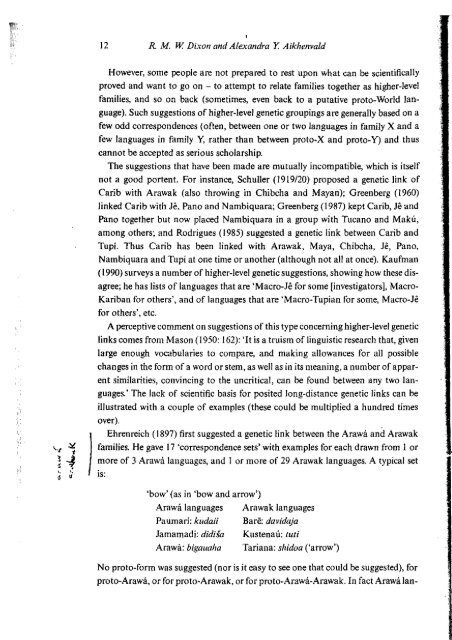The Amazonian Languages
by R.M.W. Dixon and Alexandra Y. Aikhenvald
by R.M.W. Dixon and Alexandra Y. Aikhenvald
Create successful ePaper yourself
Turn your PDF publications into a flip-book with our unique Google optimized e-Paper software.
12 R. M. W. Dixon and Alexandra Y. Aikhenvald<br />
1 Introduction<br />
13<br />
.,<br />
\." ~<br />
~<br />
·s ~ <br />
However, sorne people are not prepared to rest upon what can be scientifically<br />
proved and want to go on - to attempt to relate families together as higher-Ievel<br />
families, and so on back (sometimes, even back to a putative proto-WorId language).<br />
Such suggestions of higher-Ievel genetic groupings are generally based on a<br />
few odd corresponden ces (often, between one or two languages in family X and a<br />
few langllages in family Y, rather than between proto-X and proto-Y) and thus<br />
cannot be accepted as serious scholarship.<br />
<strong>The</strong> suggestions that have bren made are mutually incompatible, which is itseJf<br />
not a good portento For instance, Schul!er (1919120) proposed a genetic link of<br />
Carib with Arawak (also throwing in Chibcha and Mayan); Greenberg (1960)<br />
linked Carib with Je, Pano and Nambiquara; Greenberg (1987) kept Carib, Je and<br />
Pano together but now placed Nambiquara in a group with Tucano and Makú,<br />
among others; and Rodrigues (1985) suggested a genetic link between Carib and<br />
Tupí. Thus Carib has been linked with Arawak, Maya, Chibcha, Je, Pano,<br />
Nambiquara and Tupi at one time or another (although not al! at once). Kaufman<br />
(1990) surveys a number of higher-leveJ genetic suggestions, showing how these disagree;<br />
he has lists of languages that are 'Macro-le for sorne [investigators], Macro<br />
Kariban for others', and of languages that are 'Macro-Tupian for sorne, Macro-Je<br />
for others', etc.<br />
A perceptive cornment on suggestions of this type conceming higher-JeveJ genetic<br />
links comes from Mason (1950: 162): 'It is a truism of linguistic research that, given<br />
large enollgh vocabularies to compare, and making allowances for all possible<br />
changes in the form of a word or stem, as well as in ¡ts meaning, a nllmber of apparent<br />
similarities, convincing to the uncritical, can be found between any two languages.'<br />
<strong>The</strong> lack of scientific basis for posited long-distance genetic links can be<br />
iIIustrated with a couple of examples (these could be multiplied a hllndred times<br />
over).<br />
Ebrenreich (1897) first suggested a genetic link between the Amwá and Amwak<br />
families. He gave 17 'correspondence sets' with examples for each dmwn from 1 or<br />
more of 3 Arawá lallguages, and 1 or more of 29 Arawak languages. A typical set<br />
guag es all have dilferent (and unrelated) words for 'bow'. For proto-Arawak, Payne<br />
: 396) reconstructs *tapo 'bow' (a form that is in fact reflected in Tariana yawithepu<br />
'bow'). Yet on the basis of 17 sets of 'correspondences' Iike this, it was suggested<br />
that the Arawá and Arawak families are genetically related. Rivet and<br />
Tastevin (1940) followed a similar 'method', drawing odd correspondences between<br />
sorne forms in a few Arawá languages and sorne forms in a few Arawak languages<br />
(and they drew on a pool of 86 Arawak languages). A typical (short) entry from<br />
their Iist of 'cognate' sets is (Rivet and Tastevin 1940: 8):<br />
appeler ['to<br />
wawana-he, il appelle ['he calls'], Kulina [Arawá]<br />
pi-uána, bi-uána, Tariana [Arawak]<br />
<strong>The</strong> idea that Arawá (now called Madi) and Arawak are related in a family called<br />
'Arawakan' was repeated by Matteson (1972). She believed that she was demonstrating<br />
gerietic relationships by 'rigorous application of standard techniques of the<br />
comparative method' (Matteson el al. 1972: 21). <strong>The</strong> first of her 353 putative<br />
cognate sets of proto-Arawakan is (Matteson 1972: 172):<br />
1. 'abdomen' *tia-ri [in proto-Arawakan] <br />
*tika-telko, proto-Piro-Apuriná <br />
*tso-mon-tí-a, proto-Ashaninka<br />
t;<br />
*ato-fi, proto-Madi [Le. proto-Arawá]<br />
*tee-IV, proto-Newiki<br />
, Note that the only segment that the proposed proto-Arawakan reconstruction and<br />
the four intermediate reconstructions have in common is 't'.<br />
Further on in the paper, Matteson (1972: 203) gíves the Piro and Apuriná forms:<br />
l. 'abdomen' "'tiká-telko [sic, accent included here but not aboye]<br />
[proto-Piro-Apllriná]<br />
ckc:te, Piro<br />
-tikáko, Apuriná<br />
'bow' (as in 'bow and arrow')<br />
Arawá languages Arawak languages<br />
Paumarí: kudaii Bare: davidaja<br />
lamamadi: didisa Kustenaú: tuti<br />
Amwá: bigauaha Tariana: shidoa ('arrow')<br />
No proto-form was suggested (nor is it easy to see one that could be suggested), for<br />
proto-Arawá, or for proto-Arawak, or for proto-Arawá-Arawak. In fact Arawá Jan<br />
and then the forms in her Ashaninka subgroup (Matteson 1972: 211):<br />
l. 'abdomen' *tso-mon-tí-a [proto-Ashaninka] <br />
-motía, Machiguenga <br />
-tsomonte, Campa <br />
tsomollé, Nomatsigllenga <br />
In the proto-Madi section there is no word for 'abdomen'. However, the first<br />
cognate set given is (Matteson 1972: 219):


















